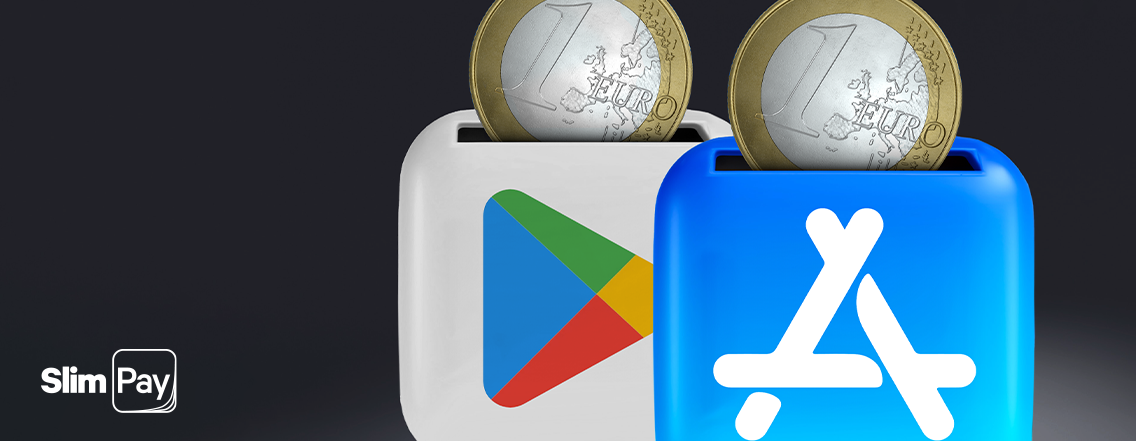As mobile applications become an increasingly popular way for businesses to offer their services and products, in-app subscription payments have become an important revenue stream. Whether it’s streaming services, fitness apps, or productivity tools, developers are increasingly leveraging subscription models to monetize their offerings. However, app stores like Apple App Store and Google Play Store limit customers’ payment options, imposing high fees and proprietary payment methods, which can eat into businesses’ revenue.
In this article, we will explore how businesses can manage in-app subscription payments, avoid high fees, and utilize alternative payment methods to offer a range of payment options to customers.
When a customer downloads an app from the Apple App Store or Google Play Store, the only payment method available for in-app purchases and subscriptions is through Apple or Google’s proprietary payment systems, subjecting businesses to burdensome fees of up to 30%. To address this issue, some businesses have tried to circumvent the proprietary payment methods by offering alternative payment options to customers. However, this can be a risky move, as Apple and Google have strict guidelines regarding alternative payment methods, and using them can result in the app being removed from their respective app stores.
After several actors raised the alarm, even leading to legal actions, it seems that the two parties responsible for monopolizing payments have already started to step back and introduce new payment options. In the following article, we will explore some of these alternative payment methods.
Regulatory Landscape of In-App Payments and the Dominance of Google and Apple in Europe
The European app market has been characterized by the dominant presence of Google and Apple, raising concerns over fair competition and limited consumer choice. To address these issues, regulatory actions have been taken, particularly in Europe, to scrutinize the practices of these tech giants and promote a more level playing field.
The European Commission has already launched several investigations into the operations of a prominent app store. One of the earliest investigations dates back to 2020. The investigation primarily focuses on two aspects: the mandatory use of Apple’s in-app purchase system and the substantial commission charged to developers. By examining these practices, the European Commission aims to determine whether they stifle competition and restrict consumer options.
The European Union Digital Markets Act (DMA), gradually applicable as of May 2nd, 2023, seeks to establish regulations governing dominant online platforms, including app stores. The DMA aims to create fair and open digital markets by addressing concerns such as unfair practices and control over access to markets. According to the European Commission, over 10,000 online platforms – of which 90% are small and medium-sized enterprises – operate in Europe, but only the largest platforms, known as “systemic” platforms, capture the majority of the value in the European digital market.
Another significant regulatory framework is the Payment Services Directive 2 (PSD2), which came into effect in September 2019. Although not directly targeting app stores, PSD2 promotes open banking and facilitates the involvement of third-party payment providers within apps. This directive offers alternative payment methods to consumers and encourages competition in the payment landscape.
Individual European countries have also taken their own measures to address the dominance of app stores. For example, Germany introduced the “Digital Competition Act” (GWB-Digital) in 2020. This legislation includes provisions to restrict certain practices of digital platforms, aiming to create a more competitive environment for developers and foster innovation.
The evolving regulatory landscape surrounding in-app payments reflects a growing effort to promote fair competition and protect consumer interests. The investigations by the European Commission, along with the proposed EU Digital Markets Act and existing regulations like PSD2, indicate a shift toward a more equitable app market. By addressing concerns over dominant market players and fostering competition, these regulatory actions aim to create a favorable environment for businesses, developers, and consumers alike.
Unlocking the Power of Alternative Payment Methods for Seamless In-App Subscription Payments
In the realm of in-app subscription payments, businesses are no longer bound by the confines of high fees and proprietary methods. As we explore the possibilities, alternative payment methods emerge as a game-changing solution. From credit card gateways to PayPal, direct debit, and even cryptocurrency or Payment Initiation Services (PIS), businesses can now revolutionize their payment landscapes to deliver a seamless and customer-centric experience. These services revolutionize the way businesses initiate and process payments, offering greater control and flexibility.
Payment Initiation Services enable businesses to initiate payments directly from customers’ bank accounts, bypassing traditional intermediaries such as credit card networks. By integrating PIS into their payment systems, businesses can offer a seamless and streamlined payment experience to their customers. This method allows for real-time transfers, reducing transaction costs and eliminating the need for intermediaries, resulting in more affordable payment processing.
One powerful alternative payment method that needs to be underlined is direct debit, enabling businesses to effortlessly withdraw funds from customers’ bank accounts on a regular basis. This method offers unrivaled convenience and cost-effectiveness, as it typically eliminates transaction fees. By implementing direct debit, businesses can streamline their payment processes, while providing customers with a hassle-free and secure payment experience.
It is important to note that businesses should carefully research the guidelines and policies of app stores before implementing any alternative payment methods, as both Apple and Google still have strict guidelines regarding alternative payment methods. Many industries are hopeful that the situation will change in the near future, following the multiple investigations and actions taken to prevent Apple and Google’s payment monopoly.
By embracing alternative payment methods, including Payment Initiation Services, businesses can not only offer a superior payment experience to their customers but also keep the relationship with the end customer and reduce involuntary churn. The availability of diverse payment options ensures that customers can choose the method that best suits their preferences and circumstances, promoting customer satisfaction and loyalty. Furthermore, the efficient and cost-effective nature of PIS contributes to a seamless payment process, minimizing disruptions and preventing involuntary churn.
SlimPay’s Alternative Payment Solution
SlimPay offers a unique alternative payment solution that is specifically designed to address the specificities of in-app subscriptions: SlimCollect. SlimCollect is a recurring payment solution powered by Open Banking, which replaces perfectly proprietary payment methods like those offered by Apple or Google.
SlimCollect Recurring offers impactful benefits to businesses. With advanced security protocols, it ensures increased data protection. The user-friendly experience streamlines payment journeys, making recurring payments simple and seamless. Additionally, it guarantees irrevocable payments, enhancing reliability and reducing disputes. By automating administrative tasks, businesses save time and costs while improving efficiency. Finally, its mobile compatibility enhances convenience, allowing policyholders to easily manage payments on their mobile devices.
SlimPay’s solution also offers advanced features, such as real-time tracking, payment monitoring, advanced reporting, automated reconciliation, and customization options, which can help businesses streamline their payment processes and reduce the administrative burden associated with managing payments. In addition, SlimPay’s solution is fully compliant with the latest security standards, ensuring that customers’ payment information is safe and secure.
Encouraging Customers to Switch Payment Methods upon subscription or during the subscription period
Encouraging customers to switch payment methods from in-app payment methods to alternative payment methods requires businesses to carefully plan and execute their strategies. It’s important to note that customers may be reluctant to switch payment methods, especially if they have been using in-app payment methods for a long time. Therefore, businesses should provide clear and concise instructions on how to switch payment methods and highlight the benefits of using alternative payment methods.
One way businesses can encourage customers to switch payment methods is by providing incentives, such as discounts or exclusive offers. For example, a business could offer a discount on their subscription fee if a customer switches to a direct debit payment method. This can be an effective way to motivate customers to switch payment methods and increase their loyalty to the business.
Businesses can also use push notifications or email campaigns to inform customers about the benefits of alternative payment methods and provide instructions on how to switch, with an easy link that will bring them directly to a checkout where they can change their method. Push notifications and email campaigns can be tailored to specific customer segments, based on their payment preferences or behavior. For example, a business could send a push notification to customers who have experienced failed payments with in-app payment methods, highlighting the reliability and convenience of direct debit.
The process of switching payment methods may vary depending on the app, but generally, customers can go to their account page, scroll down to the “Subscription” section, and tap on “Manage Subscription” and follow the process.
It’s important to note that businesses should provide clear instructions on how to switch payment methods and ensure that the process is easy and seamless for customers. Businesses should also provide support and assistance to customers who may encounter issues or have questions during the migration process.
By providing a range of payment options to customers and encouraging them to switch to alternative payment methods, businesses can not only reduce the impact of high fees and offer a better payment experience to their customers, but also keep the relationship with the end customer and reduce involuntary churn. Offering flexible payment options ensures that customers can choose the method that best suits their preferences and circumstances, increasing their satisfaction and loyalty to the business.
Conclusion
In conclusion, managing subscription payments in applications has long been a formidable challenge for businesses and app developers. The monopolistic practices of app stores like Apple and Google, characterized by high fees and exclusive payment methods, have constrained company revenues and limited customer payment options. However, the landscape is gradually shifting. Through the persistent efforts of legal battles, the introduction of new financial regulations, and the emergence of alternative payment methods, businesses now have the opportunity to offer a variety of payment options to their customers. This transformative change not only allows companies to circumvent exorbitant fees but also empowers customers to choose the payment method that aligns with their preferences. The ongoing journey towards a more equitable payment landscape promises increased competition, greater consumer choice, and a strengthened regulatory framework to combat anticompetitive practices. As the winds of change continue to blow, businesses and consumers alike can look forward to a future where subscription payments are fairer, more inclusive, and tailored to meet individual needs.




